AI or Artificial Intelligence is one of the most prevalent technologies in use nowadays, it’s quite natural to think how much will it cost us to develop or integrate AI. Whether you’re considering AI for applications, platforms, or any other digital framework, the financial aspect is crucial for businesses and individuals alike.
Sundar Pichai, the esteemed CEO of Alphabet Inc., the parent company of Google, recently provided a groundbreaking statement on AI. He stated: “AI is the greatest discovery for mankind it is bigger than even discovering electricity or fire."
with Expert AI
Development Services Contact Talentelgia for cutting-edge AI
solutions trusted by our clients in
over 20+ countries .

In this post, we will focus on the various costs that can be expected if AI has become your ultimate goal in 2024.
1.Artificial Intelligence Cost Considerations
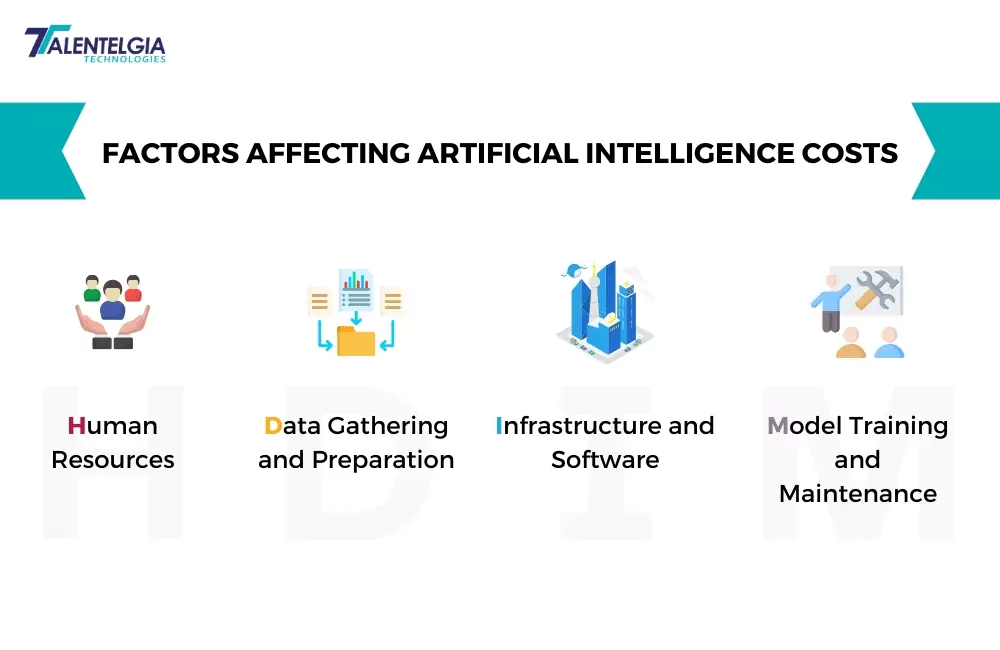
When an AI is being designed and developed, numerous cost factors appear that lead to the total budget. Here’s a breakdown of the various costs involved:
- Human Resources
And the first thing that we need is people who will make it. They encompass data scientists and engineers who perform the job of increasing the AI’s ability to learn and improve. They are essential however, they are not going to be cheap. If you bring up a group of genius-level people, you could be looking at a payroll of around $400,000 a year, just the salaries, not including health benefits or office space.
There’s the head designer, the marketing team, product managers, and developers. They help in making all tasks simpler by providing ease of use and enjoyment. For instance, they also have special skills by nature and thus they contribute to the expenses as well.
- Data Gathering and Preparation
AI is intelligent because it learns from a vast dataset When one must get the data, it is not cheap. Occasionally you will need to buy it, or you will go with the Internet and ask questions of people.
Once you have all this data, you have to make it neat so the AI can understand it. This means going through the data and fixing mistakes or taking out parts you don’t need. It can take a long time and requires people who know exactly what they’re doing, which means more costs.
- Infrastructure and Software
Now, let’s talk about the tools and tech you need. Big and complex AI programs need really strong computers to learn and work well. These computers, like those with GPUs, can be expensive. Whether you decide to buy them or rent space on them through online services like Amazon Web Services (AWS) or Google Cloud Platform (GCP), you’ll be paying quite a bit especially if the AI has to do a lot of learning.
GPU Rental Pricing on Major Cloud Platforms (as of February 26, 2024)
| Feature | Amazon Web Services (AWS) | Google Cloud Platform (GCP) |
|---|---|---|
| GPU Type | p5.xlarge (NVIDIA Tesla V100) | n2-highmem-8 (NVIDIA Tesla T4) |
| Memory | 32 GB | 16 GB |
| vCPUs | 4 | 8 |
| Price per Hour | $3.06 | $1.14 |
| Price per Day (24 hours) | $73.44 | $27.36 |
| Price per Month (730 hours) | $5343.84 | $1992.24 |
Software Licenses: The cost of software licenses for AI tools, subscriptions for programming frameworks, or charges for using cloud services can be high and vary depending on what platform you use and what features you need.
- Common AI software and Framework licensing cost
| Category | Description | Example Cost Range (Monthly) |
|---|---|---|
| AI Development Tools | Standalone software for specific tasks like data labeling, model training, or visualization. | $10 – $500+ |
| ML Frameworks (Open Source) | Free and open-source frameworks like TensorFlow, PyTorch, and scikit-learn offer core functionalities for building AI models. | Free |
| ML Frameworks (Commercial) | Commercial frameworks like H2O, Domino, and BigML provide additional features like pre-built components, collaboration tools, and automation capabilities. | $100 – $1,000+ |
| Cloud Platform Fees | Cloud platforms like AWS, GCP, and Azure offer resources for building and running AI models, including virtual machines, GPUs, and storage. | Pay-as-you-go based on usage, can range from $100 to $10,000+ |
Model Training and Maintenance
Here’s the detailed information related to model training and maintenance with a few points related to it.
Training Time
The AI model’s training can take different amounts of time from days to even months, depending on the degree of complexity and the computing resources available. Data is the pillar of AI, and it is during this learning phase that the AI would apply its algorithm to the data. This learning time is very crucial for the performance of the AI. Yet, such long training sets the cost as the highest, particularly when the high-end and powerful computers are being used.
This heavy investment is, however, a must for the AI system to be able to do information processing quickly and correctly and thus become a decision-maker.
with Professional AI
Development Services. Affordable AI solutions that can
transform your business. Contact
us now for a free consultation!

- Model Maintenance and Updates
An AI model is trained but not limited to initial training. In the same way, it is necessary to regularly update and maintain it to keep it in good working condition. It is an ongoing affair for data scientists and requires constant funding for computational infrastructure. In the long run, models may have to use advanced computer systems to keep up with the pace of technology, which we can observe from the fact that a car needs regular servicing to avoid problems.
The AI model’s consistent relevance and sharpness will require more than just starting up the process, but also allowing its continued improvement and maintenance.
Additional Costs
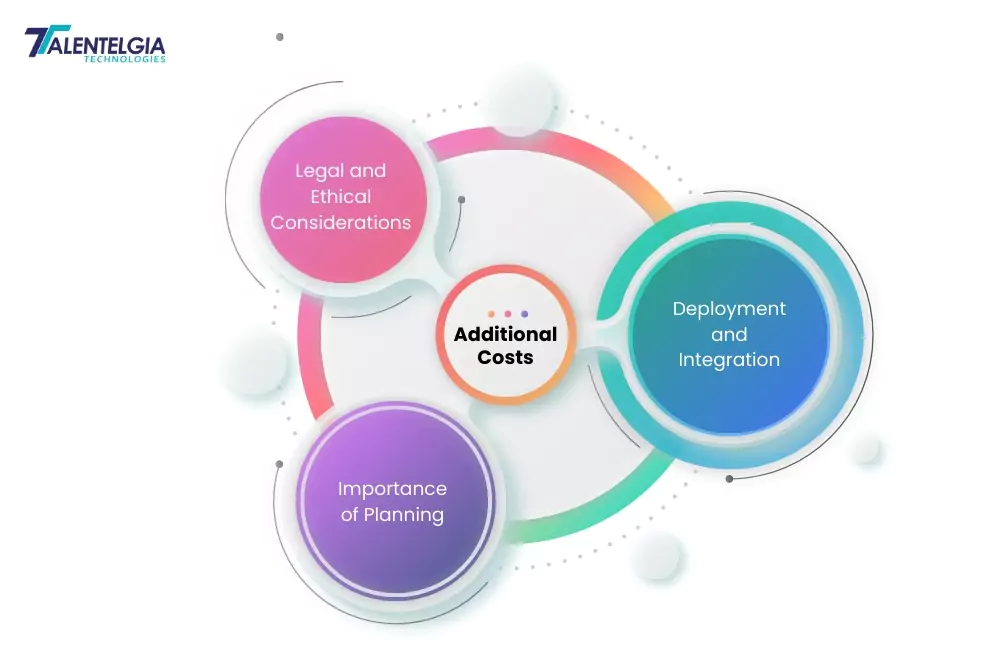
- Legal and Ethical Considerations
Adoption of AI technology concerns not only overcoming engineering difficulties. This raises a host of legal and ethical challenges, which will need to be resolved. Involving artificial intelligence (AI) systems, it is necessary to think through the consequences and whether the decision conforms to the rules. Furthermore, ethics issues arise so as to uphold trust in the public and to minimize harm. The combination of these issues often necessitates consulting with professionals with expertise in the areas of law and ethics concerning technology. The requirement for professionalization of AI projects is one of the factors that affect their expense.
The legal liability, privacy, data protection, and fairness of AI’s decision-making process are among the issues that deserve proper attention for the development of ethically sound AI.
- Deployment and Integration
However, when an AI system has been completed, there is still lot of work that needs to be done to make sure it can be implemented inside a business structure that already exists. Implementation is the stage all about how to integrate and deploy the AI within the existing technological framework of the company or setting up the AI on a new, typically serverless, platform. Each of these options requires a serious plan before undertaking. Integration might imply making the AI software interface with the various systems and databases function as a single uniform system. In some cases, it will be procedural to make the necessary modifications to the systems, which may be complex and require a large workforce.
To give an instance, moving to a serverless platform, which offers scalability and cost savings on infrastructure, may still require your company to adapt it to their requirements. Emplacement and integration both require technical skills and time so the extra costs will come with it.
- Importance of Planning
A well-thought AI project does not only function as a guide for building, rather, it becomes a point of reference for the finances involved. First, it is crucial to project all of the costs associated with the development of an AI product before the development process itself begins. This anticipation touches upon the total time for training of AI, the continuous support, and the budget both for legal and system integration. Including these aspects of AI development in the project planning phase is a way of dealing with unforeseen expenses. In charge of scheduling also includes the predetermination of resource allocation (ranging from computing equipment to human expertise). Through doing the right estimation of time and money commitments as to data preparation, algorithm development, model refinement, and other aspects organizations can set a realistic budget.
Correct planning also gives way, showing the way to the project timelines, in which each phase of the AI lifecycle is taken properly into account with sufficient attention and resources. Finally, the plan which will take into account both fiscal responsibility and the success of the project leads to the mitigation of surprises that can bring total havoc and derail both budget and timeline. Effective planning, however, is not just about cost containment. It is also about creating a solid framework for AI deployment that can achieve its potential and contribute to the company’s competitive advantage.
- Cost Range
Free to $40,000 per year
If you go for pre-built AI business solutions like chatbots or basic tools, some might be free, while others with advanced features may cost up to $40,000 per year.
$6,000 to $300,000+
AI projects that are custom-made for one specific task may cost anything between $6000 to over $300,000. It can be so wide-ranging, and influenced by factors as the complexity of the project depends on how skilled the team, the resources needed such as the high-tech hardware and the specialized software.
Key takeaways
- Hiring AI People: Getting a team of smart people like data scientists costs a lot. You might spend over $400,000 a year just paying them, not counting additional expenses like benefits or office space.
- Getting Data Ready: Gathering info (data) and getting it ready for the AI is expensive. You might have to buy data or collect it, and then spend a lot of time sorting it out.
- Tech and Tools: You need really good computers and programs for AI, which can be super pricey, whether you buy them or pay to use them online through services like AWS or Google Cloud.
- Training the AI: Making the AI learn and keeping it smart takes a lot of time and money, just like taking care of a car to make sure it keeps running well.
- Extra Expenses: Think about costs for legal advice, putting the AI into your business, and making it work with what you already have. It’s important to plan your money right from the start.
- How Much You’ll Spend: The price for AI can be anywhere from almost nothing for basic applications to $300,000 or more for advanced custom projects. If you use ready-made AI services, they might be free or up to $40,000 per year, depending on what you need.
2. Cost Based on Technology
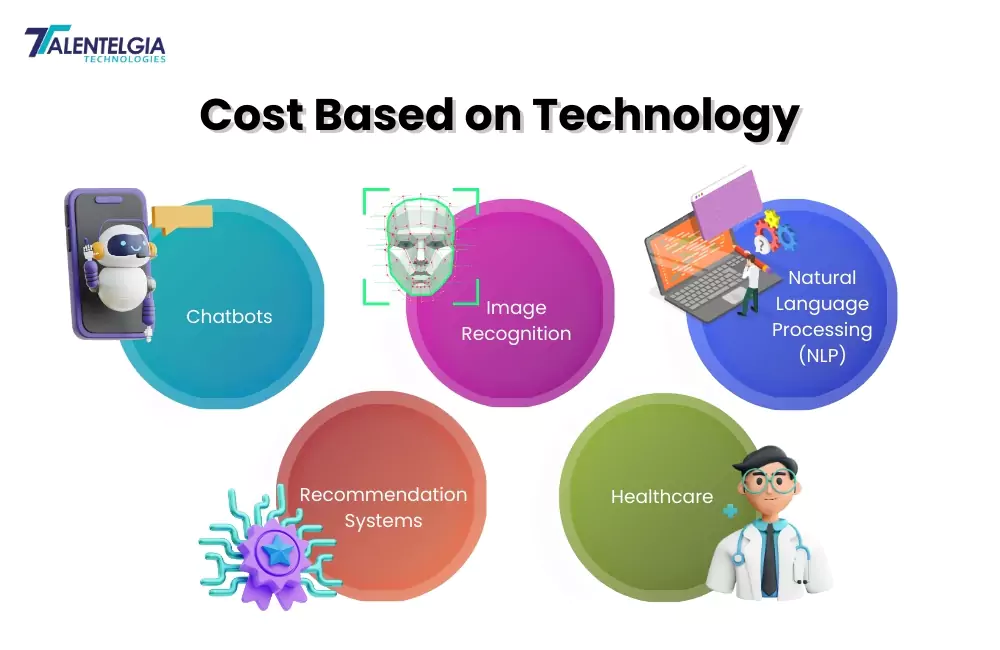
| Factor | Description | India (Hourly Rate) | Europe (Hourly Rate) | US (Hourly Rate) | Total Expected Price (Range) |
|---|---|---|---|---|---|
| Type of Software | Range of applications from voice assistants to expert systems; influences complexity and cost. | $30-$90 | $35-$100 | $80-$250 | $50,000 – $200,000 |
| Level of Intelligence | Categorized as narrow AI (task-specific) or truly intelligent; impacts the depth of learning and overall cost. | $40-$100 | $50-$120 | $100-$300 | $80,000 – $250,000 |
| Data Quality and Quantity | Quality and quantity of data significantly impact AI performance; structured data is cheaper to work with. | $25-$80 | $30-$90 | $70-$200 | $40,000 – $150,000 |
| Custom vs. Pre-built | Custom solutions tailored to specific needs may cost between $6,000 to over $300,000; pre-built solutions are more affordable. | $6,000-$300,000 | $10,000-$200,000 | $20,000-$500,000 | $15,000 – $400,000 |
| Geographic Factors | Costs vary based on region; India has lower hourly rates, Europe (Central/Eastern) rates range, US has higher rates. | $30-$90 | $35-$100 | $80-$250 | $60,000 – $220,000 |
| Maximizing ROI | Strategic approach to maximize return on investment; consider business needs and specific AI problem-solving goals. | $50-$120 | $60-$150 | $120-$350 | $100,000 – $300,000 |
- Robotic Process Automation (RPA)
Robotic Process Automation (RPA) is a system that involves a robot, which eliminates tiring rule-based jobs and functions such as data entry, form filling, and back-office support. These processes automation does not have the same risk of fatigue and errors that human workers encounter, so they provide consistency and speed to the regular operating functions.
When RPA is implemented into the business process, the company profited from a higher level of efficiency, because virtual robots complete routine tasks with 100% accuracy so the human staff is free to do more complex and strategic work. The investment in RPA development companies, therefore, is characterized by the acceleration of performance in repetitive business functions.
- Speech Recognition
Voice-based speech recognition technology is the technology that takes voice into text and thus, the entire functionality of Siri or Alexa is made possible. This innovative interface tool dramatically reduces the complexity of the interaction between humans and machines by allowing users to communicate with various appliances via voice commands. The technology is the soul of the services that convert dictations to typing and of the applications that offer voice control features for more convenience and accessibility.
The making of the important speech recognition system requires the investment in machine learning and natural language processing among other elements for it to be able to understand the different accents, dialects, and speech patterns.
- Computer Vision
Computer vision grants machines the capability to perceive and interpret visual information from the environment, akin to human sight but through cameras and sensors. This technology powers a range of applications, including facial recognition systems, content analysis in images and videos, autonomous vehicle navigation, and the evaluation of medical imagery like X-rays and scans.
The development of computer vision involves sophisticated algorithms designed to mimic the complexities of human vision, requiring significant investment in research and computational resources to achieve levels of accuracy and reliability suitable for critical applications.
- Generative AI
Generative AI stands at the frontier of artificial creativity, capable of crafting novel content such as realistic images, music, and personalized text messages. It employs advanced algorithms that draw upon vast datasets to produce original creations, emulating human artistry.
This artificial intelligence genre has transformative implications for sectors such as marketing, entertainment, and design by automating the generation of unique content and experiences. For example, advanced Gen AI tools like Editpad Paragraph Generator can create 100% unique, engaging, and readable content pieces on any topic or keyword with a single click.
The development of such AI involves an understanding of intricate patterns and data trends, necessitating substantial investment to harness its potential for innovation and customization.
- Data Science
Data science lies at the heart of AI, it makes use of mathematical techniques and sophisticated algorithms to extract insights from large sets of data. This field is fundamental to realizing smarter, more efficient AI systems that can tackle a wide array of problems. Data science enables the discerning interpretation of data, paving the way for machine learning models that can predict trends, optimize decisions, and personalize experiences.
The intellectual rigor and computational intensity required to process and analyze voluminous data for meaningful information make data science a pivotal, yet resource-intensive aspect of AI development and implementation.
3. Cost Based on Applications
| Application | Hourly Price (USD) | Total Expected Price (USD) |
|---|---|---|
| Chatbots |
|
|
| Image Recognition |
|
|
| Natural Language Processing (NLP) |
|
|
| Recommendation Systems |
|
|
- Chatbots
In the landscape of digital communication, chatbots serve as intelligent virtual assistants that simulate human interaction to handle customer inquiries and automated tasks with remarkable efficiency. They are designed to engage customers through text-based conversations, addressing questions and executing requests without the need for live agents. The sophistication of these chatbots can be paralleled to having an ever-present, supportive friend dedicated to resolving your needs at any hour, providing a seamless and personalized customer experience.
The cost attributed to the development of chatbots is contingent on the intricacies of the tasks they are expected to undertake and the level of conversational intelligence they exhibit. A more complex chatbot capable of handling a broader array of inquiries with nuanced understanding commands a higher investment. This is due to the advanced artificial intelligence and machine learning components necessary to process natural language and provide accurate responses.
- Image Recognition
Image Recognition technology allows computers to interpret and analyze visual data using algorithms akin to human vision, endowing machines with an almost sentient ability to recognize and respond to images. From identifying facial features to classifying various objects, these sophisticated systems necessitate advanced programming and continual learning from vast image datasets to ensure precision. The development and calibration of image recognition algorithms are both resource-intensive and time-consuming, directly impacting project budgets.
The expense related to implementing such technology is correlated to the level of accuracy and speed required for the tasks at hand. High-resolution recognition demands a substantial computational load and refined algorithmic accuracy, resulting in increased financial commitments. Industries ranging from security to healthcare rely on image recognition for their precision-dependent applications, such as identifying individuals or diagnosing illnesses from medical imagery.
- Natural Language Processing (NLP)
Natural Language Processing (NLP) represents a leap forward in enabling machines to interpret and emulate human language, facilitating effortless interactions between humans and computers. The development of NLP technology relies on complex algorithms that imbue computers with the ability to comprehend spoken or written language and respond intelligently. NLP systems are intricate, designed to grasp the nuances and idioms of diverse languages, and thereby command significant investment, especially for models trained in multiple languages or specialized vocabularies.
The cost dynamics for NLP systems are dictated by the depth and breadth of understanding required, the context within which the system will operate, and the fluidity of human-like responses expected by users. The intricacy of mimicking human interaction – including humor, sarcasm, and cultural references – is a notable challenge that elevates the investment needed.
- Recommendation Systems
Recommendation systems epitomize the essence of personalized service, subtly guiding users toward choices aligned with their established preferences. Resembling an intuitive companion, these systems analyze past behavior to suggest products, services, or content tailored to individual tastes. The deployment of recommendation systems involves algorithms that scrutinize large pools of user data, anticipate preferences, and deliver suitably refined suggestions, which entails extensive research and algorithmic design.
Investments in these systems should account for the complex machine-learning processes that scrutinize user data to understand and predict preferences. As the sophistication of recommendation engines increases, so too does the cost associated with their development and maintenance.
- Healthcare
AI healthcare app development marks a transformative juncture, contributing significantly to diagnostics, therapeutic innovation, and bespoke patient care plans. In healthcare, AI assists clinicians and researchers by parsing through massive datasets to identify patterns, optimize treatments, and even expedite the discovery of new medication, functioning as an auxiliary to human expertise. The stakes in healthcare are exceedingly high, demanding not just precision but also a comprehensive understanding of complex medical conditions, which inherently escalates the costs involved in implementing AI.
Financial investment in AI for healthcare reflects the need for cutting-edge technology that abides by rigorous regulatory standards and clinical precision. It encompasses the outlay for data processing infrastructure, the development of algorithms capable of learning from multifaceted medical data, and expertise in both technology and healthcare to accurately implement and oversee AI applications.
4. Factors Affecting AI Cost
- AI Complexity: If you want AI to perform a job like sorting, it will be affordable. However, for a highly advanced self-driving car, expect to pay more.
- Customization vs. Pre-built: If you have AI customized from scratch, it will be more expensive compared to using pre-existing software with slight adjustments to fit your needs.
- Team Expertise: Recruiting highly skilled individuals literate in data science and engineering will result in higher costs compared to hiring those who may not be as literate.
- Data Requirements: AI needs examples to learn. The more and better the examples, the higher the cost. Learning a new language is somewhat similar – more good books and teachers lead to better learning.
- Hardware and Software: Artificial intelligence generally requires powerful computers. The more powerful the computer (especially those with GPUs), the quicker the learning process. However, such powerful computers can be too expensive.
5. Additional Considerations
Ongoing Costs: After creating AI, you might incur costs for its smooth running, similar to regular car servicing. This could involve checking or fixing components and paying for essentials to keep the AI operational.
Alternatives: Before spending money, consider exploring free AI tools and systems. Sometimes, if you’re lucky, they can meet your needs without significant expenses.
6. Key Takeaways
- Different Software, Different Costs: The kind of AI, like a simple talking assistant or a more complex system, changes how hard it is to make and how much it will cost.
- Smarter AI, Higher Price: If the AI is just really good at one thing (narrow AI) it’s one thing, but if it’s meant to be super smart and understand lots, it will need more work and more money.
- Data Matters: Having the right kind of information for the AI to learn from is a big deal. Top-notch and well-organized data makes the AI better but costs less than messy data that AI has to sort out first.
- Build Your Own or Buy Ready-Made: Making your own AI that’s just right for your needs could be pricey, maybe $6,000 and up, but you can also choose off-the-shelf options that might be less costly.
7. FAQs
How much can I expect to pay for AI talent in 2024?
In 2024, hiring AI talent like data scientists and engineers may cost over $150,000 per year for each experienced individual. The total yearly cost for a team will likely be in the hundreds of thousands when including benefits and administrative expenses.
Is it necessary to purchase data for AI, and if so, what are the typical costs in 2024?
Whether you will need to buy data or not, if the volume of data you plan to use is small, you might be able to use the data you already have. Buying a dataset starts at around a hundred to a thousand dollars, while customizing the data costs more. While the general collection is free, think of the costs for preparation and cleaning.
What are the infrastructure costs for running AI models in 2024?
Infrastructure costs could be either higher for on-premises or could be lower for cloud services. These services can be billed either at a few hundred dollars or several thousand dollars monthly, and on-premises hardware is initially expensive but may be cost-effective for large-scale projects.
Can I use open-source software for AI, and is it truly free?
Open-source AI frameworks such as TensorFlow and PyTorch can be free of charge, but custom development and support services could be extra expenses for companies. While training and support of these technologies may, indeed, add to the expenses.
What is the average cost to develop an AI application in 2024?
The development cost is highly variable, with the level of complexity being a determining factor. In the range from a few thousand dollars for a prototype to millions for a full product line, the costs may vary.
Conclusion
As we wrap up our discussion on the costs of AI in 2024, it’s clear that creating smarter machines isn’t cheap. Companies have to spend a lot of cash to pay the smart people—like data scientists and engineers—who make AI happen. Sometimes, these costs can be more than $400,000 a year for a team. Then there are the ‘teaching materials’ for AI, which is the data it learns from. Getting the right data can be a big expense, whether it’s buying it or taking the time to gather it properly. Moreover, organizing this data is not an easy task that requires expertise from professionals who are well-versed in AI. The gears turning behind the AI—like really powerful computers—also cost a pretty penny. Even deciding to borrow these through cloud services, you’ll still see the dollars adding up, especially if your AI needs to do a lot of learning. So, even though making these smart machines is not light on the wallet, the tasks they can do is make businesses sit up and take notice. It’s like what Sundar Pichai said about AI being a groundbreaking discovery. Yes, the costs may be substantial, but the changes AI can bring might just be worth it. Investing in AI means betting on a future where cutting-edge ideas might change how we do everything, which could be priceless.


 Healthcare App Development Services
Healthcare App Development Services
 Real Estate Web Development Services
Real Estate Web Development Services
 E-Commerce App Development Services
E-Commerce App Development Services E-Commerce Web Development Services
E-Commerce Web Development Services Blockchain E-commerce Development Company
Blockchain E-commerce Development Company
 Fintech App Development Services
Fintech App Development Services Fintech Web Development
Fintech Web Development Blockchain Fintech Development Company
Blockchain Fintech Development Company
 E-Learning App Development Services
E-Learning App Development Services
 Restaurant App Development Company
Restaurant App Development Company
 Mobile Game Development Company
Mobile Game Development Company
 Travel App Development Company
Travel App Development Company
 Automotive Web Design
Automotive Web Design
 AI Traffic Management System
AI Traffic Management System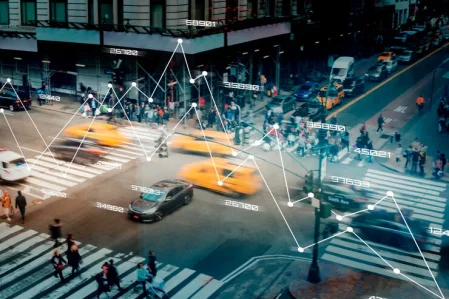
 AI Inventory Management Software
AI Inventory Management Software
 AI Software Development
AI Software Development  AI Development Company
AI Development Company  AI App Development Services
AI App Development Services  ChatGPT integration services
ChatGPT integration services  AI Integration Services
AI Integration Services  Generative AI Development Services
Generative AI Development Services  Natural Language Processing Company
Natural Language Processing Company Machine Learning Development
Machine Learning Development  Machine learning consulting services
Machine learning consulting services  Blockchain Development
Blockchain Development  Blockchain Software Development
Blockchain Software Development  Smart Contract Development Company
Smart Contract Development Company  NFT Marketplace Development Services
NFT Marketplace Development Services  Asset Tokenization Company
Asset Tokenization Company DeFi Wallet Development Company
DeFi Wallet Development Company Mobile App Development
Mobile App Development  IOS App Development
IOS App Development  Android App Development
Android App Development  Cross-Platform App Development
Cross-Platform App Development  Augmented Reality (AR) App Development
Augmented Reality (AR) App Development  Virtual Reality (VR) App Development
Virtual Reality (VR) App Development  Web App Development
Web App Development  SaaS App Development
SaaS App Development Flutter
Flutter  React Native
React Native  Swift (IOS)
Swift (IOS)  Kotlin (Android)
Kotlin (Android)  Mean Stack Development
Mean Stack Development  AngularJS Development
AngularJS Development  MongoDB Development
MongoDB Development  Nodejs Development
Nodejs Development  Database Development
Database Development Ruby on Rails Development
Ruby on Rails Development Expressjs Development
Expressjs Development  Full Stack Development
Full Stack Development  Web Development Services
Web Development Services  Laravel Development
Laravel Development  LAMP Development
LAMP Development  Custom PHP Development
Custom PHP Development  .Net Development
.Net Development  User Experience Design Services
User Experience Design Services  User Interface Design Services
User Interface Design Services  Automated Testing
Automated Testing  Manual Testing
Manual Testing  Digital Marketing Services
Digital Marketing Services 
 Ride-Sharing And Taxi Services
Ride-Sharing And Taxi Services Food Delivery Services
Food Delivery Services Grocery Delivery Services
Grocery Delivery Services Transportation And Logistics
Transportation And Logistics Car Wash App
Car Wash App Home Services App
Home Services App ERP Development Services
ERP Development Services CMS Development Services
CMS Development Services LMS Development
LMS Development CRM Development
CRM Development DevOps Development Services
DevOps Development Services AI Business Solutions
AI Business Solutions AI Cloud Solutions
AI Cloud Solutions AI Chatbot Development
AI Chatbot Development API Development
API Development Blockchain Product Development
Blockchain Product Development Cryptocurrency Wallet Development
Cryptocurrency Wallet Development About Talentelgia
About Talentelgia  Our Team
Our Team  Our Culture
Our Culture 
 Healthcare App Development Services
Healthcare App Development Services Real Estate Web Development Services
Real Estate Web Development Services E-Commerce App Development Services
E-Commerce App Development Services E-Commerce Web Development Services
E-Commerce Web Development Services Blockchain E-commerce
Development Company
Blockchain E-commerce
Development Company Fintech App Development Services
Fintech App Development Services Finance Web Development
Finance Web Development Blockchain Fintech
Development Company
Blockchain Fintech
Development Company E-Learning App Development Services
E-Learning App Development Services Restaurant App Development Company
Restaurant App Development Company Mobile Game Development Company
Mobile Game Development Company Travel App Development Company
Travel App Development Company Automotive Web Design
Automotive Web Design AI Traffic Management System
AI Traffic Management System AI Inventory Management Software
AI Inventory Management Software AI Software Development
AI Software Development AI Development Company
AI Development Company ChatGPT integration services
ChatGPT integration services AI Integration Services
AI Integration Services Machine Learning Development
Machine Learning Development Machine learning consulting services
Machine learning consulting services Blockchain Development
Blockchain Development Blockchain Software Development
Blockchain Software Development Smart contract development company
Smart contract development company NFT marketplace development services
NFT marketplace development services IOS App Development
IOS App Development Android App Development
Android App Development Cross-Platform App Development
Cross-Platform App Development Augmented Reality (AR) App
Development
Augmented Reality (AR) App
Development Virtual Reality (VR) App Development
Virtual Reality (VR) App Development Web App Development
Web App Development Flutter
Flutter React
Native
React
Native Swift
(IOS)
Swift
(IOS) Kotlin (Android)
Kotlin (Android) MEAN Stack Development
MEAN Stack Development AngularJS Development
AngularJS Development MongoDB Development
MongoDB Development Nodejs Development
Nodejs Development Database development services
Database development services Ruby on Rails Development services
Ruby on Rails Development services Expressjs Development
Expressjs Development Full Stack Development
Full Stack Development Web Development Services
Web Development Services Laravel Development
Laravel Development LAMP
Development
LAMP
Development Custom PHP Development
Custom PHP Development User Experience Design Services
User Experience Design Services User Interface Design Services
User Interface Design Services Automated Testing
Automated Testing Manual
Testing
Manual
Testing About Talentelgia
About Talentelgia Our Team
Our Team Our Culture
Our Culture
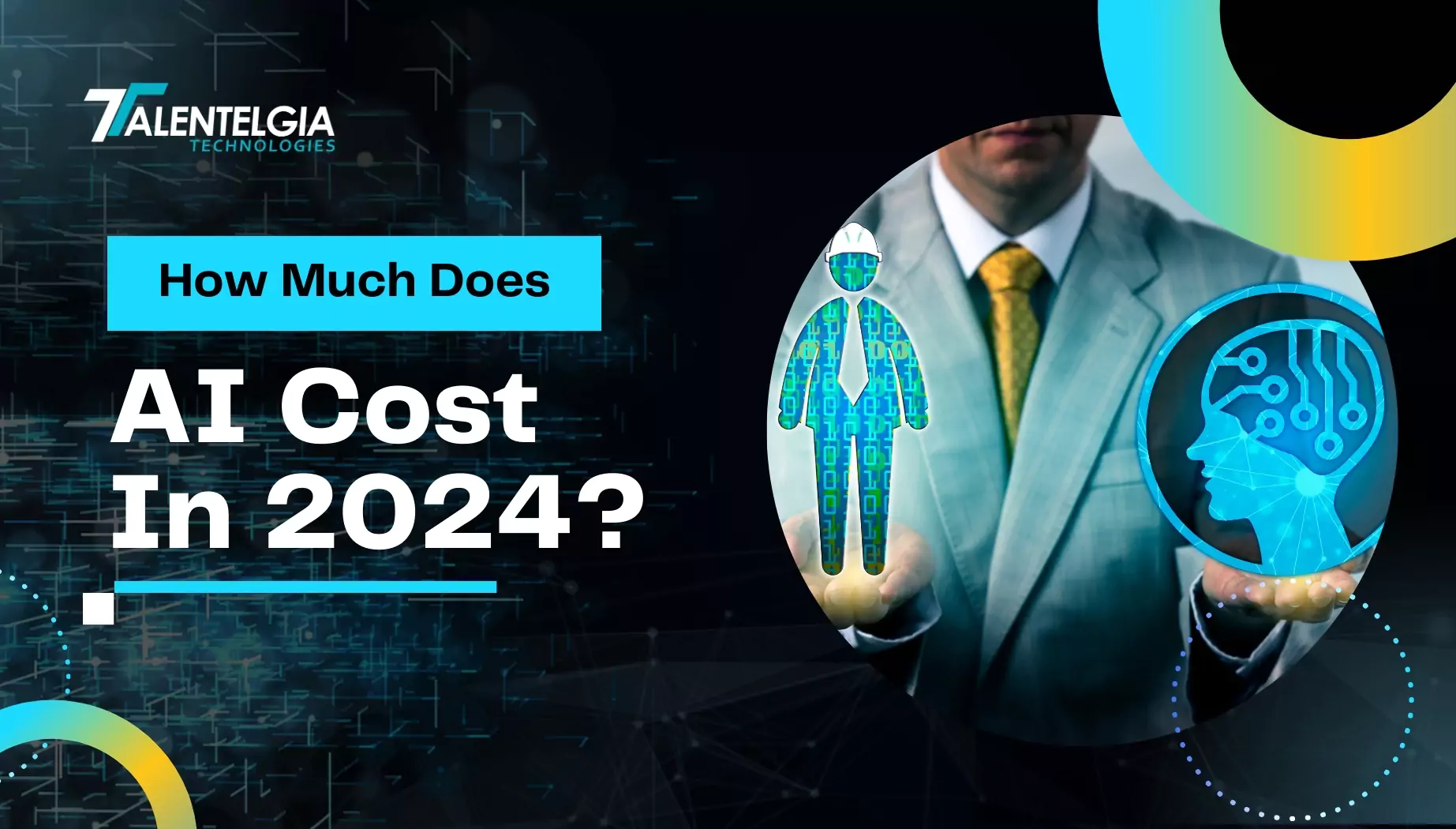

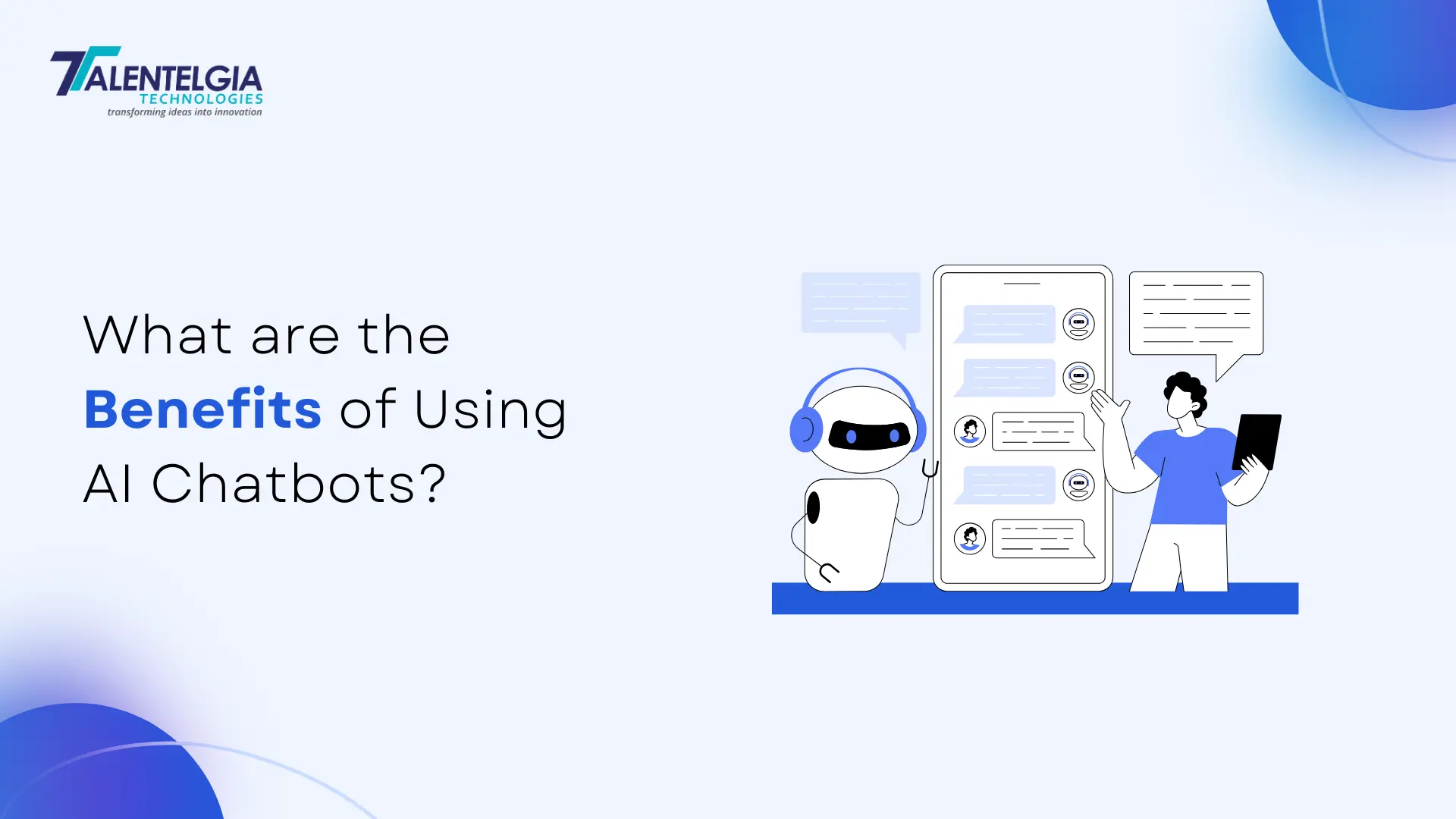

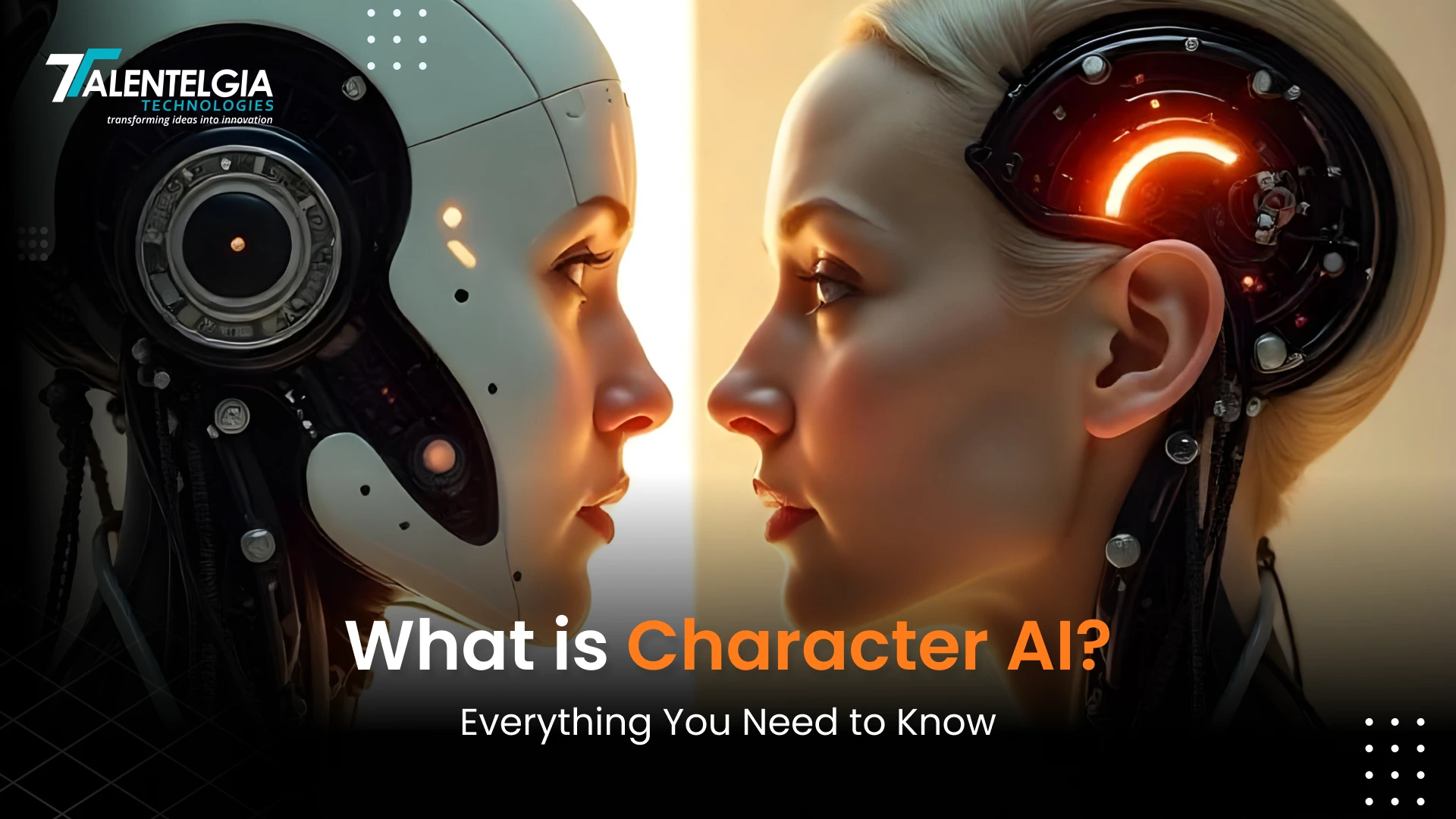
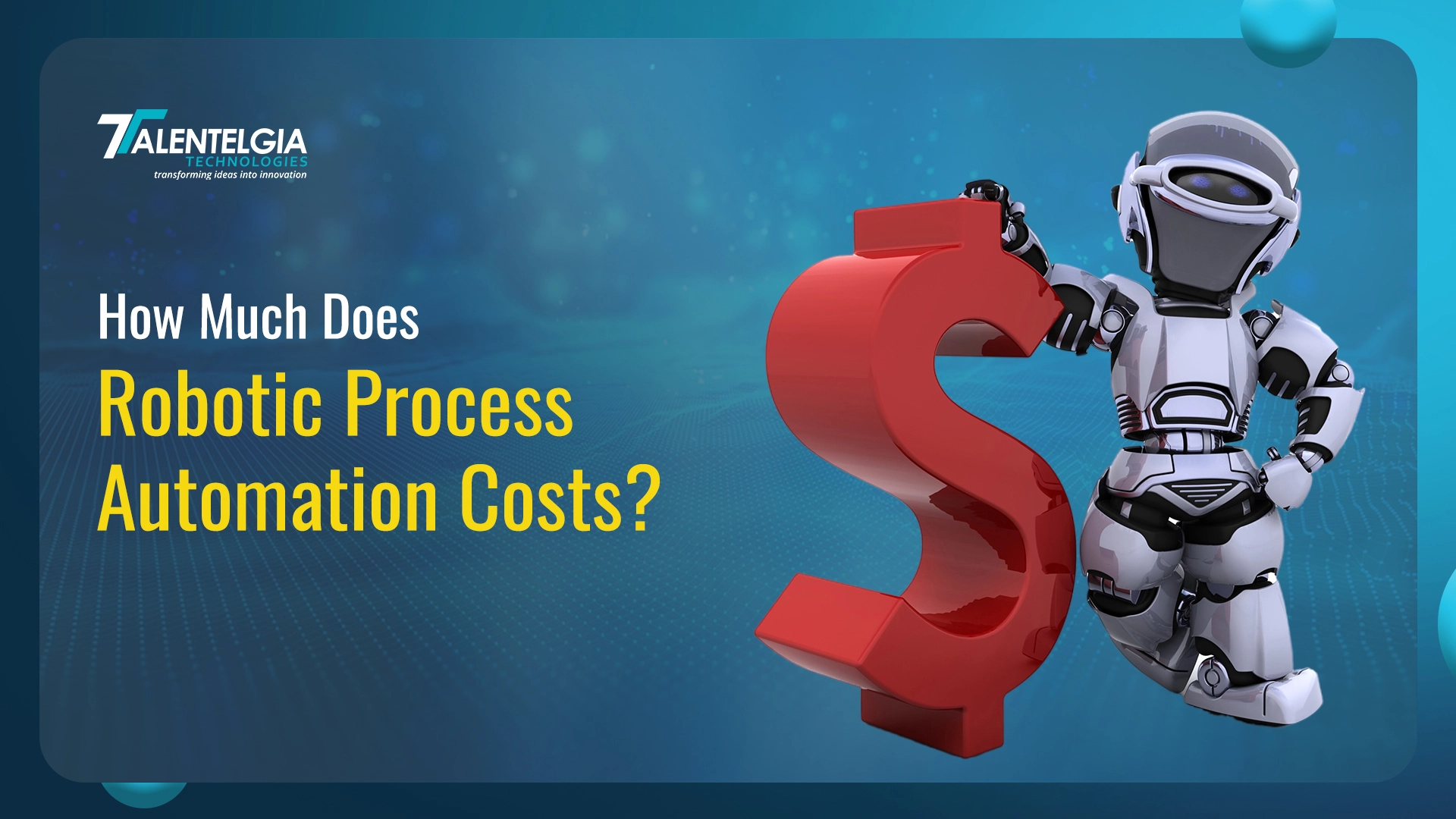










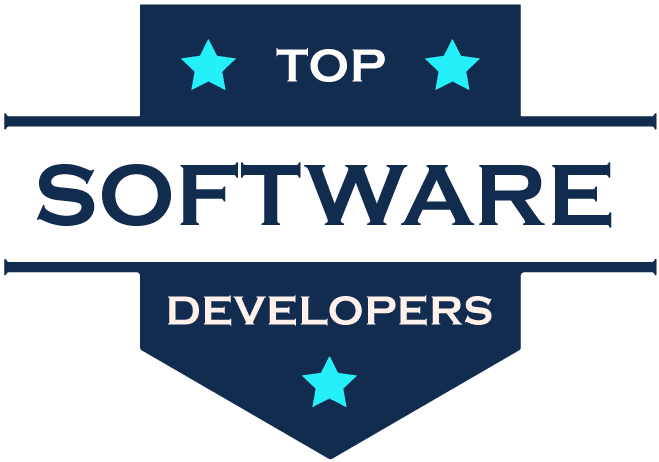
 Write us on:
Write us on:  Business queries:
Business queries:  HR:
HR: 




